The Dallas Museum of Art has agreed to return six looted antiquities from its collection and announced a broad new initiative to exchange expertise and artwork with cultural institutions around the world.
“The problems of illegal excavation and the illicit import of cultural property require the consideration of new models of cooperation among institutions,” the museum said in a release announcing the initiative, dubbed the Dallas Museum of Art Exchange Program, or DMX.
The effort was announced Monday while signing an agreement with Turkey, the museum’s first partner, for the return of the Orpheus Mosaic, a Roman mosaic floor looted near Edessa (today’s Sanliurfa) and acquired at a Christies auction by the DMA in 1999.
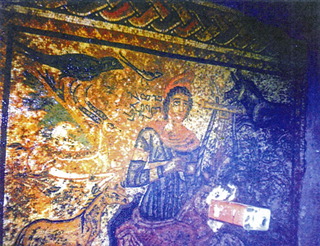 In explaining the return, the museum cited compelling new evidence presented by Turkish investigators about the mosaic’s illicit origins: “Two newly recovered in situ photos of the mosaic showing it being removed by the smugglers. The photographs also show the full work with its decorative borders intact, prior to it being removed from the ground. The photographs were printed by a local photo shop in Sanliurfa and are currently evidence in a criminal investigation being carried out by the Sanliurfa Head Prosecutor in order to identify everyone involved in the crime.” The image shows the mosaic with a border that was likely removed by looters, the museum notes, adding, ” The canister visible in the lower right contains a Turkish brand of glue, which looters–not archaeologists–would have used to make repairs.”
In explaining the return, the museum cited compelling new evidence presented by Turkish investigators about the mosaic’s illicit origins: “Two newly recovered in situ photos of the mosaic showing it being removed by the smugglers. The photographs also show the full work with its decorative borders intact, prior to it being removed from the ground. The photographs were printed by a local photo shop in Sanliurfa and are currently evidence in a criminal investigation being carried out by the Sanliurfa Head Prosecutor in order to identify everyone involved in the crime.” The image shows the mosaic with a border that was likely removed by looters, the museum notes, adding, ” The canister visible in the lower right contains a Turkish brand of glue, which looters–not archaeologists–would have used to make repairs.”
Notably, the Dallas museum initiated the return of the mosaic instead of waiting for it to be identified by Turkish authorities, who have been on a campaign to repatriate looted antiquities. Soon after Maxwell Anderson started as director in January, he asked the museum’s antiquities curators to identify objects with troubling ownership histories. The mosaic was found to be nearly identical to several published on a website of Turkey of looted objects. Anderson told the Dallas Morning News:
the last thing he wanted was “to be the recipient of a claim by Turkey and be unprepared, seeing all of that evidence. So, I wrote to the embassy, saying if you have any information about this mosaic, please let us know. I didn’t have any specific information, but it seemed circumstantially that it was very likely that it was removed from that site.” Turkish officials came forward with the photograph of the mosaic, “which is all you need to know,” Anderson said.
In addition to the Orpheus mosaic, the Dallas museum agreed to return five antiquities to Italy in response to law enforcement requests. All five Two of those objects were first questioned by us in a Jan. 11 email to the museum inquiring about links between the DMA and the illicit trade, including antiquities dealer Edoardo Almagia. After our inquiry, the DMA contacted Italy and has now agreed to return them.
UPDATE: In February, we requested provenance information for 15 of the DMA’s recent acquisitions, including the five pieces returned this week, that we selected at random. They helpfully provided the list we posted here. We asked yesterday on Twitter whether other objects on that list might also be returned — several come from dealers who have also been implicated in the illicit trade. A museum spokeswoman now tells us: “Italian and Greek authorities have reviewed our collections records, including the works you refer to in your recent post, and have advanced no other claims.” Of course, some of the material on the list, such as the Cycladic figurine, likely came from other countries.
The objects going back to Italy — and the DMA’s explanation for their return — offer a helpful who’s who of the illicit antiquities trade.
Two Etruscan shields with the head of Acheloos (Etruscan 6th Century BC)
Volute Krater (Pulian, 4th Century BC).
As we noted in February, both were purchased from antiquities dealer Edoardo Almagià in 1998. The museum describes Almagià as “a former New York antiquities dealer…currently named in a criminal case for conspiracy to commit the illegal export and smuggling of cultural property pending before the Public Prosecutor of Rome. Almagià has been under investigation since at least 2006, when U.S. Customs officials raided his New York apartment, confiscating photographs, documents, and archaeological material. He was also the subject of a New York Times story in 2010 that revealed he and Michael Padgett, former antiquities curator at the Princeton University Art Museum, were the focus of an investigation of the illegal export and laundering of Italian archaeological objects. The Italian government named Almagià in the criminal case for having ‘sold, donated, or lent’ nearly two dozen works looted from Italian sites to the Princeton Museum. Roughly twenty other objects are listed in the case as having been obtained illegally by Almagià and sold to other American institutions in the 1980s and 1990s, including this pair of shields.” UPDATE: The DMA incorrectly referred to Padgett as the former antiquities curator at Princeton. The Princeton Museum confirms he remains on staff there, and the DMA has corrected is post.
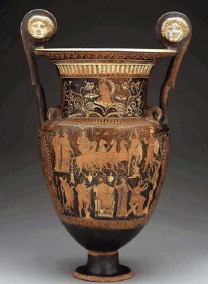 As evidence that the statue and krater were looted, the museum cited “photographs provided that were seized by U.S. Immigration and Customs Enforcement officials” and “archival evidence seized by U.S. Immigration and Customs Enforcement officials, including records of sales and correspondence currently serving as evidence in the criminal investigation and court case.”
As evidence that the statue and krater were looted, the museum cited “photographs provided that were seized by U.S. Immigration and Customs Enforcement officials” and “archival evidence seized by U.S. Immigration and Customs Enforcement officials, including records of sales and correspondence currently serving as evidence in the criminal investigation and court case.”
Dallas now joins the Met and Princeton in returning objects linked to the dealer. (We’ve written about those returns here and here.) Will the other museums we’ve identified with Almagia material — including the Getty, the Boston MFA, San Antonio Museum of Art, Indiana University — now be motivated to do the same?
 A Red Figure krater (Apulia, 4th Century BC) acquired by DMA at Sotheby’s in 1996.
A Red Figure krater (Apulia, 4th Century BC) acquired by DMA at Sotheby’s in 1996.
A Calxy Krater (Campagnia, 4th Century BC) acquired from the vases form Ward and Co. around 2005, said to be from a “Swiss private collection.”
Both vases have been linked to Gianfranco Becchina, who the museum describes as “a Sicilian antiquities dealer who has been convicted in Italy of dealing in stolen antiquities. Becchina started dealing in antiquities from his premises in Basel, Switzerland, in the 1970s and is said to have sold to several major museums, sometimes through Sotheby’s and Christie’s auction houses in London. In May 2002, the Carabinieri, in collaboration with the Swiss police, raided his storage facilities in Basel, recovering thousands of objects in various stages of restorations, photographs of artifacts, and other documents.”
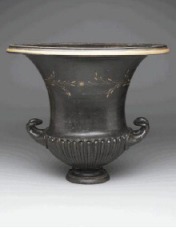 “The J. Paul Getty Museum and the Toledo Museum of Art have both returned material to Italy that was acquired from Becchina and subsequently shown to have been illegally exported.”
“The J. Paul Getty Museum and the Toledo Museum of Art have both returned material to Italy that was acquired from Becchina and subsequently shown to have been illegally exported.”
“In April 2012 U.S. Immigration and Customs Enforcement seized two works from Christie’s New York auction house that were associated with the investigation of Becchina. According to the Carabinieri, Gianfranco Becchina has been identified as one of the most prolific known traffickers of Italian cultural heritage, and all property that has been shown to have been illicitly trafficked by Becchina is subject to confiscation.”
You can find a list of our previous posts mentioning Becchina here.
 Etruscan head of an Antefix. Said to be from Henri Jacques of Geneva. Purchased from Robin Symes in about 1999.
Etruscan head of an Antefix. Said to be from Henri Jacques of Geneva. Purchased from Robin Symes in about 1999.
A photograph linked this antefix to Giacomo Medici, who the museum describes as “a former antiquities dealer based in Rome, Italy, and Geneva, Switzerland, who was found guilty of receiving stolen goods, illegal export of goods, and conspiracy to traffic by the Italian government and sentenced to ten years in prison and a €10 million fine. In 1995 the Carabinieri, in concert with Swiss police, raided Medici’s storage space in Geneva, which contained thousands of objects, photographs (including many Polaroids), and documents relating to his business practices and connections. The Cleveland Museum of Art, J. Paul Getty Museum, and Metropolitan Museum of Art have all returned objects that were acquired via Giacomo Medici. Along with Gianfranco Becchina, he has been identified by the Carabinieri as one of the most prolific known traffickers of Italian cultural heritage.”
Robin Symes, the dealer form whom the DMA purchased the objects, has also been linked to the illicit trade, the museum notes. “Symes is also accused of playing a pivotal role in the illegal trade of looted antiquities. Several museums, including the Metropolitan Museum of Art and the Minneapolis Institute of Arts, have already returned several objects acquired through Symes. He is known to have commercial relations with dealer Giacomo Medici, who was the ultimate source of the artifacts that would subsequently be sold through dealers or auction houses. Prior to the Medici conviction, Robin Symes had been involved in a civil court case, and in January 2005 he was sentenced to two years in prison for contempt of court for not fully disclosing his assets.”
You can find our other posts mentioning Symes here.
We’ll have more on the significance of the returns and the DMA’s new loans initiative in a future post.

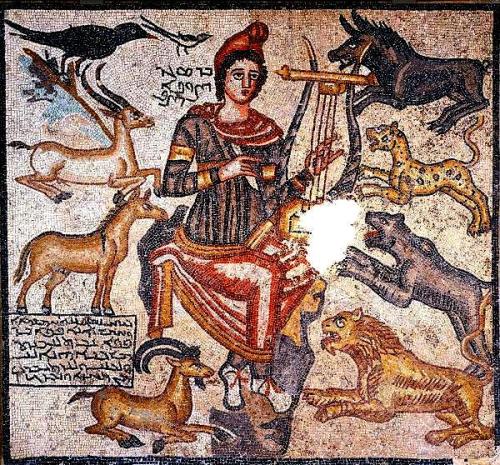
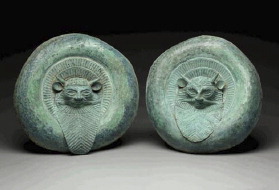

I’m truly enjoying the design and layout of your site.
It’s a very easy on the eyes which makes it much more pleasant for me to
come here and visit more often. Did you hire out a designer
to create your theme? Excellent work!
Pingback: Boston MFA’s Provenance Research Reveals The Illicit Trade In African Antiquities | CHASING APHRODITE
Pingback: Stolen Deities Resurface in a Dallas Museum – Yakanak News
Pingback: Stolen Deities Resurface in a Dallas Museum | Sculptor Central